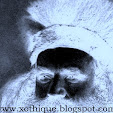Slide photo by Bruce W. Falk; WWII-era Naval station, Dutch Harbor, Alaska, circa 1958.

A new cartoon I created (drawn digitally), based on my mother's accounts of a restaurant operated by Greek immigrants, where she was employed as a waitress. The time frame was toward the end of World War Two.
Parental slide photo (by Bruce W., or Hazel M. Falk). Inscription Rock, El Morro National Monument, New Mexico; circa 1958.
A photo I took; Great Buddha at Kamakura, Japan; 5 December, 2024. The moon and Venus appeared behind stacks of fulgent clouds; crows flew and rasped in mystery, about the evocative statue.
I recently discovered (reading in a poetry anthology), that the poem, The Wreck of the Deutschland, by Gerard Manley Hopkins, contained an indirect reference to my ancestor, Adalbert Falk. The mention was not in a favorable sense. In the piece I assembled above, I selected the extract from Hopkins' poem from: Poetry Foundation. -JF, 2-11-2024

Here is a bit of postal/correspondence material (from 1958) from my father's (Bruce W. Falk) time in Alaska, connected with the White Alice project. -JF
Here are WWII-era draft cards for Jerome Horwitz, Louis Feinberg, Moe Horwitz, and Samuel Horwitz (AKA Curly Howard, Larry Fine, Moe Howard, and Shemp Howard, all members of the Three Stooges, in various lineups -- along with Joe Besser, and Curly Joe De Rita). The draft cards have a straightforward, sober feel, in contrast with the Stooges' comic personae. Source: Ancestry .com
--JF
On October 8th and 9th, I shewed up (as I have many times, starting with the first one) at the H.P. Lovecraft Film Festival, at the Hollywood Theatre; staying for two full days. I took in Freeze, directed by Charlie Steeds, Short Blocks Three, Re-Animator, and Bride of Re-Animator (both followed by question-and-answer sessions, with Jeffrey Combs -- he made reference, to among other things, how Re-Animator originally took off through word-of-mouth, and then rentals). I also attended a showing of Night of the Comet (first time for me to viddy this hilarious, and atmospherically campy cult film), with Kelli Maroney appearing afterward (she provided great insights into the movie, mentioning for example that the sequences at the department store were filmed after hours, at the real deal).
I also attended some panel discussions, on Lovecraft's Favorite Films, The Aquatic Origins of Weird and Cosmic Terror; along with one on comics, and one on video games. Sipping beer, then alternately removing a mask, I tossed the panels a couple questions, including one involving Fritz Lang's Die Nibelungen; and another with reference to Skull Comix.
Above: An instant photo I took, 23 June, 2022, at the Oregon Vietnam Veterans Memorial. And this post marks the 14th anniversary of this here blog; which started in the murk and distance of 2008.